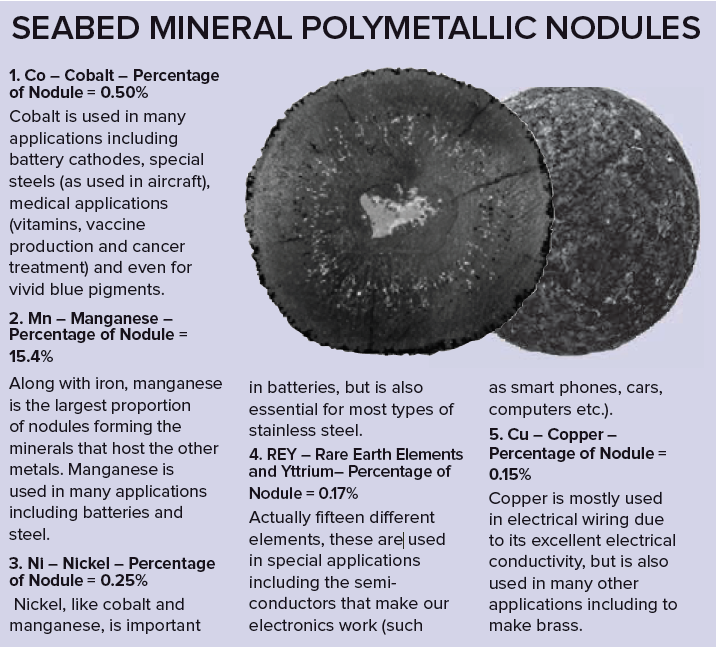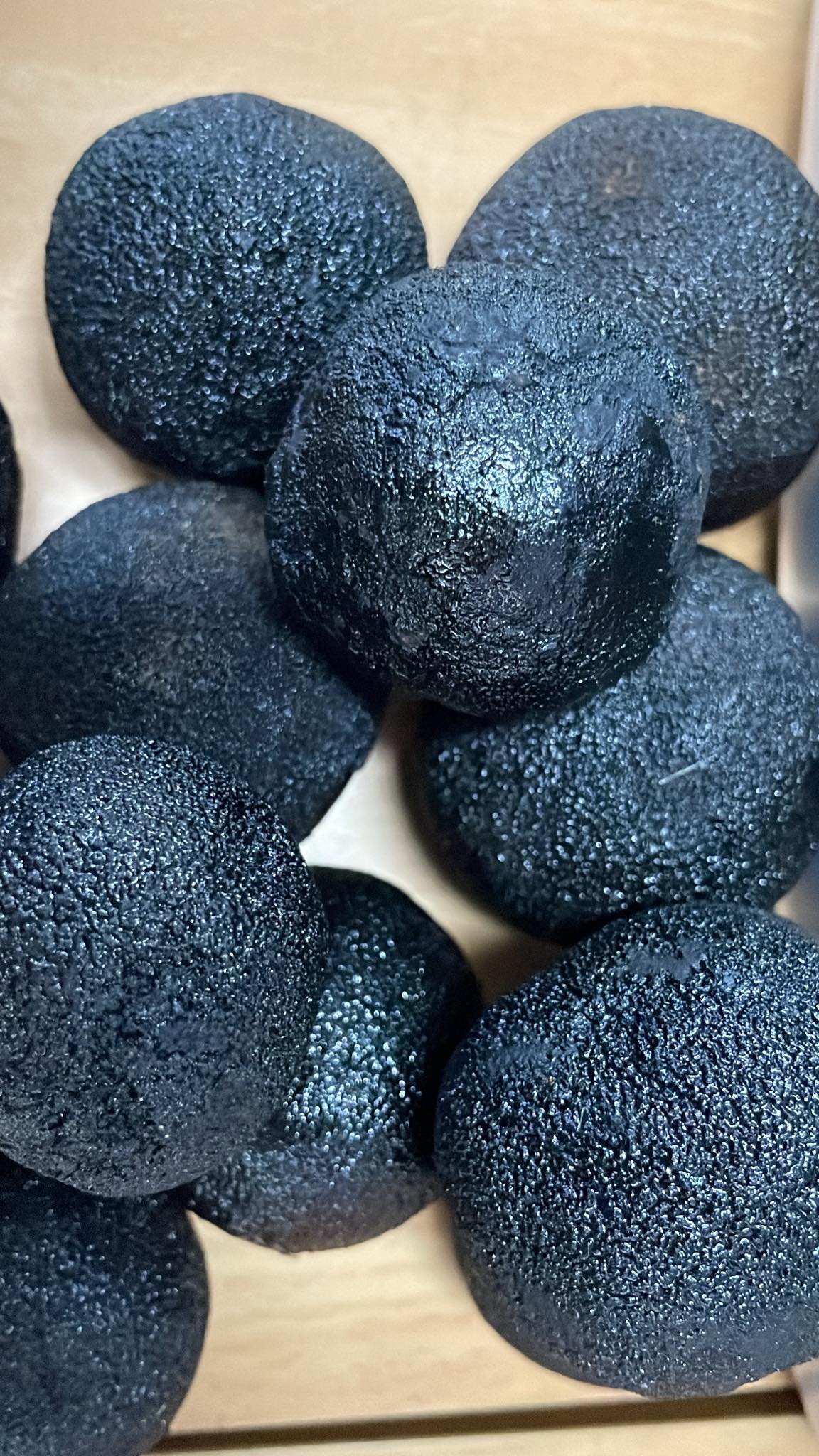WHAT ON EARTH UNDER SEA ARE POLYMETALIC NODULES
In the Cook Islands, we are embarking on an exciting journey to explore our Exclusive Economic Zone1, delving into the depths in search of polymetallic nodules (or simply nodules) and other scientific discoveries. Our mission involves gathering data from a vast area of the ocean, our Marae Moana, and over the next few years we will talk about some of the exciting science and technology that make this voyage possible.
How do nodules form?
Before we dive into the intricacies of the technology driving this journey, it’s important to understand what nodules are and why they’re often the focus of exploration. These mysterious formations resemble hard, black potato-like balls
made of iron and manganese oxide2. They develop right on the muddy seabed, often in areas of ocean floor that have never been thoroughly explored. Nodules form through a fascinating process: manganese and iron gradually precipitate around a nucleus, such as a clay fragment or old fish tooth, accumulating layer by layer. This natural phenomenon occurs at various depths, but its most prevalent in the deep ocean basins, typically between 4,000 to 6,000 meters below the surface3.
Picture then these nodules as tiny, sponge-like structures absorbing not just manganese and iron from the seawater but also other valuable metals such
as nickel, cobalt, copper, titanium, and even rare earth elements. As they grow, they become repositories of precious resources, ofering insights into the complex chemistry and geology of the deep sea4.
Nodules range in size from less than 1 cm to more than 20 cm in diameter. These curious formations don’t rush their growth – they add just about a centimetre every million years. For comparison, your fingernails grow a centimetre in about three months. So
a 2 cm radius nodule could have taken 2 million years to reach its current size. Depending on how quickly they grow, their surfaces can be smooth, rough, or knobby like a cauliflower. It is also
interesting that the processes that form nodules were active in ancient oceans as well as modern oceans—we find nodules in some ancient sedimentary rocks that are more than 540 million years old5, so nodules are naturally recycled through the earth’s processes from time to time.
Most nodules are uncovered on the sea floor, but some get buried; some have been found hundreds of metres below the sea floor. You might wonder, with all the sediment falling down, why aren’t they all buried? Well, it turns out, that both deep sea creatures like maturori, and ocean currents can sweep the sediment of the nodules.
The chemistry of the nodules varies depending on where they form. Firstly ones close to land have more land sourced elements like silicon in them, secondly nodules that form in deeper waters have more iron and cobalt in them. The nodules can also record changes over long periods of time e.g. changes in ocean chemistry from glaciation events and even reversals in the direction of the earth’s magnetic pole 6.
The early discovery of nodules
Humans first discovered nodules in the deep sea about 150 years ago as technology to explore these depths became available. One of the most famous expeditions was the three year voyage of the HMS Challenger7.
Challenger came from Hawaii right past the Cook Islands in 1875. The crew of the Challenger used winches to lower metal sample dredge baskets on long cables before dragging them short distances along the sea floor to collect biological and geological samples. The crew were very surprised to find nodules in all of the world’s major oceans. The same basic technology is still used today to recover nodules, but of course using modern stronger and lighter materials.
The HMS Challenger and subsequent surveys showed that nodules are found around the world, but they are most abundant in the Pacific and Indian Oceans. Today after more exploration in the 1980s and 90s8 we know that one of the greatest concentrations is around the Cook Islands9.
The potential value of nodules
The value of nodules depends on their chemistry – what they’re made of - (like if they’re rich in cobalt or nickel) and how much those minerals are worth on the market at the time10. Metal prices changes depend on growing or falling demand and then responses in supply – this can be volatile within a year or two but in the longer-term fundamental needs are more important. Interest in extraction of nodules began in the 1960s and 1970s as the world economy and standards of living started to accelerate. A global recession in the 1980s stopped things for a while, but today, land based metal deposits are becoming harder to find.
Today some of the metals found in nodules, particularly cobalt, nickel and copper, are in short supply. These metals are vital for the technology that will make a modern, low-carbon world a reality. Independent analysts also claim that demand for these sorts of metals is expected to continue to increase, even once recycling and other new technologies are considered11. So if nodules in the Cook Islands can be extracted responsibly and sustainably then the revenue from them could make our economy more resilient and improve the livelihood of our people.
Possible Figures: nodules on the sea floor, a nodule, cross-section of a nodule, hms challenger
1. Cook Islands Seabed Minerals Authority. Historic First Seabed Minerals Exploration Licences Granted. https://www.sbma.gov.ck/news-3/article-88 (2022).
2. McCormack, G. Cook Islands Seabed Minerals. A Precautionary Approach to Mining. (Cook Islands Natural Heritage Trust, Rarotonga, Cook Islands, 2016).
3. Browne, R., Parianos, J. & Murphy, A. Geomorphology of the Cook Islands, tropical South Pacific Ocean. J. Maps 1–7 (2023) doi:10.1080/17445647.2023.2169889.
4. International Seabed Authority. A Prospector’s Guide for Polymetallic Nodule Deposits in the Clarion-Clipperton Fracture Zone. (2010).
5. Jenkyns, H. C. Fossil nodules. in Marine Manganese Deposits (ed. Glasby, G. P.) 87–108 (Elsevier Oceanography Series, Amsterdam, Holland, 1977).
6. Yi, L. et al. The Potential of Marine Ferromanganese Nodules From Eastern Pacific as Recorders of Earth’s Magnetic Field Changes During the Past 4.7 Myr: A Geochronological Study by Magnetic Scanning and Authigenic 10 Be/ 9 Be Dating. J. Geophys. Res. Solid Earth 125, (2020).
7. Murray, J. & Renard, A. F. Deep-Sea Deposits (Based on the Specimens Collected during the Voyage of HMS Challenger in the Years 1872 to 1876). http://www.vliz.be/nl/open-marien-archief?module=ref&refid=41584 (1891).
8. JICA-MMAJ. Report on the Cooperative Study Project on the Deepsea Mineral Resources in Selected Offshore Area on the Sopac Region. (2001).
9. RSC. Cook Islands Polymetallic Nodule Deposit. (2023).
10. Cardno. An Assessment of the Costs and Benefits of Mining Deep-Sea Minerals in the Pacific Island Region: Deep-Sea Mining Cost-Benefit Analysis / Pacific Community. https://dsm.gsd.spc.int/images/pdf_files/PIR_CBA_Report.pdf (2016).
11. International Energy Agency. Critical Minerals Market Review 2023. https://www.iea.org/reports/critical-minerals-market-review-2023/ (2023).



